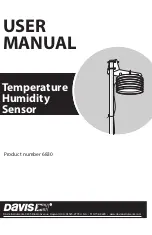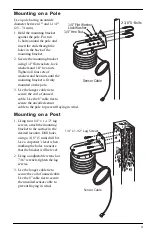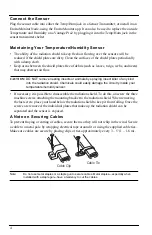
2
Prepare the Temperature/Humidity Sensor
Rotate the Mounting
Bracket.
To facilitate packing and shipping
the Temperature/Humidity Sensor,
the mounting bracket is installed
upside down at the factory. For
best air flow through the shield as
well as ease of installation, we
suggest you flip it over.
1. Place the
Temperature/Humidity Sensor
on a table or other level work
surface.
2. Remove the three 5/8”
mounting screws and lock
washers that hold the mounting
bracket and the radiation shield
together as shown in the
illustration.
3. Remove the mounting bracket,
flip it over and replace it on the
radiation shield.
4. Fasten the mounting bracket in
place using the three screws and lock washers.
Before You Install the Temperature/Humidity Sensor
Choose a Location
It is important to remember to choose a location that best represents the environment you
would like to monitor and/or protect. Consider the following factors as you choose a location:
• Do not mount the sensor near any source of cold or heat that might distort temperature
measurements.
• The sensor’s radiation shield works best in a location with a steady breeze. Mount it away
from fences, buildings, trees, or other obstructions.
• Mount the sensor over vegetation or soil if possible.
• Do not install over or near sprinklers, which may inflate humidity values.
For In-Canopy Monitoring Locations
• Place the sensor well inside the canopy, thoroughly surrounded by vegetation and out of
direct sunlight, as much as possible.
For Frost Monitoring Locations
• Place the sensor at about 5' (1.5m) in a grassy, open field that receives the coldest
temperatures adjacent to the area at risk of frost damage.
Radiation
Shield
Assembly
Remove
and Flip
Mounting
Bracket
Remove
Mounting
Screws and
Lock
Washers
Summary of Contents for 6830
Page 2: ......


























